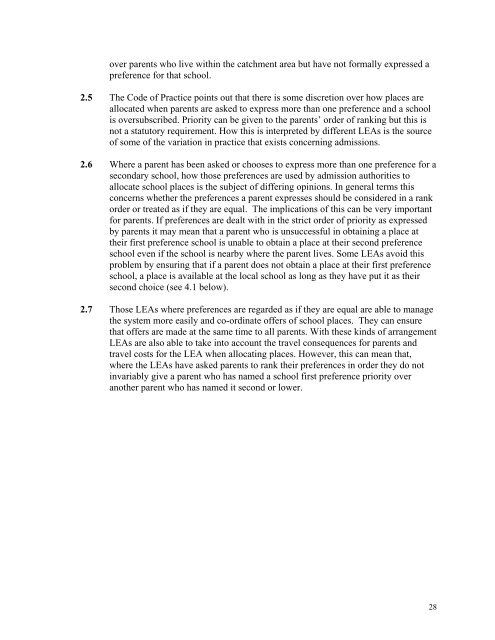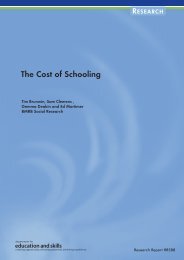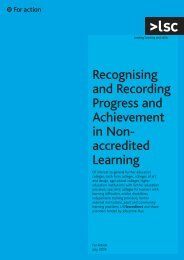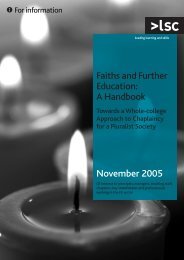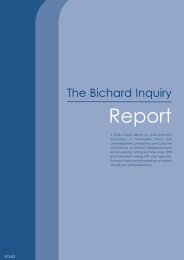Parents' Experiences of the Process of Choosing a Secondary School
Parents' Experiences of the Process of Choosing a Secondary School
Parents' Experiences of the Process of Choosing a Secondary School
Create successful ePaper yourself
Turn your PDF publications into a flip-book with our unique Google optimized e-Paper software.
over parents who live within <strong>the</strong> catchment area but have not formally expressed a<br />
preference for that school.<br />
2.5 The Code <strong>of</strong> Practice points out that <strong>the</strong>re is some discretion over how places are<br />
allocated when parents are asked to express more than one preference and a school<br />
is oversubscribed. Priority can be given to <strong>the</strong> parents’ order <strong>of</strong> ranking but this is<br />
not a statutory requirement. How this is interpreted by different LEAs is <strong>the</strong> source<br />
<strong>of</strong> some <strong>of</strong> <strong>the</strong> variation in practice that exists concerning admissions.<br />
2.6 Where a parent has been asked or chooses to express more than one preference for a<br />
secondary school, how those preferences are used by admission authorities to<br />
allocate school places is <strong>the</strong> subject <strong>of</strong> differing opinions. In general terms this<br />
concerns whe<strong>the</strong>r <strong>the</strong> preferences a parent expresses should be considered in a rank<br />
order or treated as if <strong>the</strong>y are equal. The implications <strong>of</strong> this can be very important<br />
for parents. If preferences are dealt with in <strong>the</strong> strict order <strong>of</strong> priority as expressed<br />
by parents it may mean that a parent who is unsuccessful in obtaining a place at<br />
<strong>the</strong>ir first preference school is unable to obtain a place at <strong>the</strong>ir second preference<br />
school even if <strong>the</strong> school is nearby where <strong>the</strong> parent lives. Some LEAs avoid this<br />
problem by ensuring that if a parent does not obtain a place at <strong>the</strong>ir first preference<br />
school, a place is available at <strong>the</strong> local school as long as <strong>the</strong>y have put it as <strong>the</strong>ir<br />
second choice (see 4.1 below).<br />
2.7 Those LEAs where preferences are regarded as if <strong>the</strong>y are equal are able to manage<br />
<strong>the</strong> system more easily and co-ordinate <strong>of</strong>fers <strong>of</strong> school places. They can ensure<br />
that <strong>of</strong>fers are made at <strong>the</strong> same time to all parents. With <strong>the</strong>se kinds <strong>of</strong> arrangement<br />
LEAs are also able to take into account <strong>the</strong> travel consequences for parents and<br />
travel costs for <strong>the</strong> LEA when allocating places. However, this can mean that,<br />
where <strong>the</strong> LEAs have asked parents to rank <strong>the</strong>ir preferences in order <strong>the</strong>y do not<br />
invariably give a parent who has named a school first preference priority over<br />
ano<strong>the</strong>r parent who has named it second or lower.<br />
28


